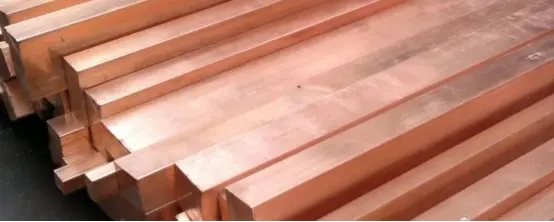
Knowledge
Vacuum Brazing Process for Red Copper

Copper has excellent electrical conductivity, thermal conductivity, corrosion resistance, ductility and certain strength. Adding various alloy elements to copper can improve its corrosion resistance, strength and improve its machinability.
Base material:
1. Pure copper (divided into oxygen-containing copper and oxygen-free copper)
Composition: Copper content ≥ 99.5%, may contain a small amount of impurities (such as oxygen, sulfur, lead).
Characteristics: Excellent electrical conductivity (about 100% IACS) and thermal conductivity, but the oxygen content is relatively high (the oxygen content of common red copper such as T2 is about 0.06% - 0.1%).
Common grades: T1 (copper ≥ 99.95%), T2 (copper ≥ 99.90%), T3 (copper ≥ 99.70%). Usage scenarios
It is suitable for general conductive or heat-conductive scenarios (such as household cables, pipes, copper radiators, copper cold plates, etc.) and is cost-sensitive.
The oxides Cu2O or CuO formed on the surface of pure copper are easy to remove, so the brazing property of pure copper is very good.
Oxygen copper contains copper oxide. If brazing is carried out in a reducing atmosphere containing hydrogen, hydrogen will diffuse into the copper, reduce the copper oxide and form water vapor. In severe cases, the copper may break. Pure copper cannot be strengthened by heat treatment. The strength of cold-worked pure copper will decrease after brazing, especially after furnace brazing, pure copper will become very soft. When choosing the heating method for brazing, the softening problem of pure copper should be fully considered.
2. Oxygen-free copper:
Composition: Copper content ≥ 99.99%, oxygen content ≤ 0.003% (such as TU0, TU1, etc.).
Characteristics: Virtually free of oxygen, higher electrical conductivity (approaching theoretical value), better resistance to hydrogen embrittlement and processing performance.
Common grades: TU0, TU1, TU2 Usage scenarios
To meet the requirements of high purity and low oxygen content, such as:
-Vacuum environments (oxygen impurities can easily cause discharge or contamination).
- High-frequency electronics (high conductivity reduces signal loss).
- Precision machining (preventing oxidation from causing cracking).
Today's introduction of the vacuum brazing process and performance research of red copper involves the following key technical points:
1. Silver-copper eutectic solder (AgCu28) process
◎ Optimal parameters:
When the brazing temperature is 810-850℃ and the holding time is 5 minutes, the shear strength of the joint reaches the maximum value of 240 MPa; the strength decreases when the temperature exceeds 850℃.
◎ Microstructure:
◇ The joint is composed of a copper-based solid solution (close to the base metal side) and a silver-copper eutectic structure (at the center of the brazing seam).
◇ As the temperature increases, the copper-based solid solution layer thickens, the eutectic layer thins, and the overall width of the brazing seam decreases.
◎ Fracture mode:
Fractures mostly occur at the interface between the copper-based solid solution and the silver-copper eutectic structure.
◎ Advantages of vacuum brazing:
Avoid oxidation, reduce residual stress, no flux required, and reduce porosity and slag inclusion defects.
2. Amorphous copper-phosphorus solder (Cu-Ni-Sn-P) process
◎ Process optimization:
◇ The amorphous solder has a melting point 4.5℃ lower than that of common solders, with a reduced crystallization range of 3.5℃, and significantly improved wettability (larger spreading area).
◇ The best wettability is achieved at 680℃ for 20 minutes, with a spreading area of 270mm².
◎ Microstructure:
◇ The brittle phase Cu₃P in the weld seam decreases with the extension of holding time, while the plastic Cu-based solid solution increases, enhancing the joint strength.
◎ Element diffusion: Sn, Ni, and P diffuse significantly with the base material, and the reaction wettability is dominant, resulting in a tight interface bonding.
3. Summary of Key Parameters
| Solder Type | Optimal Brazing Temperature | Holding Time | Shear Strength/Wettability |
| Silver-Copper Solder | 850°C | 5 minutes | Maximum shear strength 238 MPa |
| Copper-Phosphorus Amorphous | 680°C | 20 minutes | Maximum spreading area 269 mm², optimized tensile properties |
4. Comparison of Differences
◎AgCu28 Solder
Form: Solder paste, solder wire, solder sheet. It is suitable for scenarios with high strength requirements, but its temperature window is relatively narrow (820~950℃).
◎Amorphous Copper Phosphorus Solder
Form: Solder paste, amorphous strip. It has better wettability and reduced brittleness, making it suitable for precision soldering that requires a low melting point and easy formability.
5. Additionally, silver-copper-phosphorus solder
The phosphorus element in the solder helps enhance the solder's self-fluxing ability, thereby eliminating the need for additional flux during the soldering process. The solder has good fluidity and wettability, and is specifically used for soldering copper and copper alloys.
Application scenarios:
◇ Silver-copper-phosphorus solder is an ideal choice for connecting copper and copper alloys. It is very popular in the HVAC industry and is typically used in the HVAC/R (heating, ventilation, air conditioning, and refrigeration) industry to connect copper tubes and components in refrigeration systems, heat exchangers, and air conditioning units;
◇ In the automotive field, it is used for welding fuel lines and transmission components;
◇ The low melting point and self-fluxing characteristics are also suitable for pipe applications and other copper-based connections.
◇ Vacuum switches, contacts, electrical materials soldering
BCuP-5 (15 silver-copper-phosphorus), BCuP8 (18 silver-copper-phosphorus) (in the form of solder paste or solder sheet) are also used as vacuum brazing filler metals for red copper.
In practical applications, the type of brazing filler metal and process parameters should be selected based on specific circumstances to optimize performance.



